Sarkar N. (ed.) Human-Robot Interaction
Подождите немного. Документ загружается.

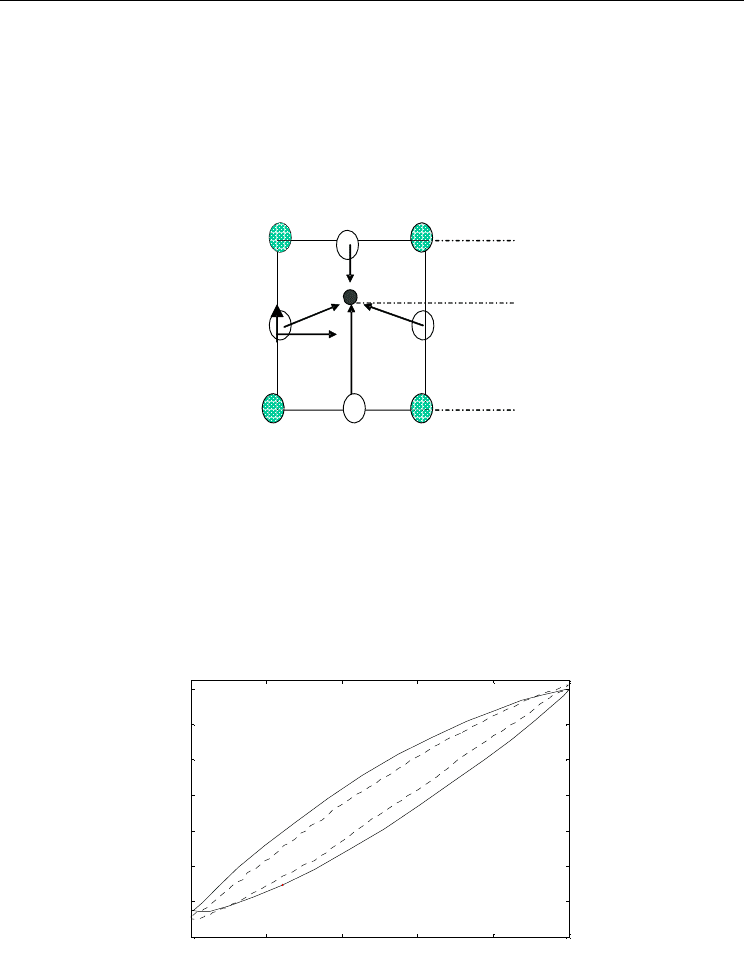
Modeling and Control of Piezoelectric Actuators for Active Physiological Tremor Compensation
371
solution of PbZrO
3
and PbTiO
3
and the general formula is Pb(Zr
y
Ti
1-y
)O
3
. PZT has the
pervoskite ABO
3
structure (Fig. 2).
When a voltage is applied across the ceramic, the potential difference causes the atom at the
centre (Zr or Ti) to displace (Fig. 3). A pole is thus induced and the net polarization in the
PZT ceramic changes. This results in the deformation of the material. An opposite
phenomenon occurs when the ceramic is loaded with a force. A change in polarization
occurs and a voltage potential difference is induced. This explains why piezoelectric
materials are commonly used both as actuators and sensors.
Figure 3. Polarization
A piezoelectric ceramic is an excellent choice because of its ability to output a large force,
large operating bandwidth and fast response time. Unfortunately, effective employment of
piezoelectric actuators in micro-scale dynamic trajectory-tracking applications is limited by
two factors: (1) the intrinsic hysteretic behavior of piezoelectric material, and (2) structural
vibration. The maximum hysteretic error is typically about 15%. To make matters worse, the
hysteresis path changes according to rate (Fig. 4), as time is needed for the atoms to move
and switching of the polarization to adjust and settle down. Landauer et al. [Landauer et al.,
1956] discussed about the dependence of the polarization, in barium titanate, on the rate at
which the field is cycled.
0 20 40 60 80 100
0
2
4
6
8
10
12
14
Figure 4. Hysteresis Path at different frequency
While research on rate-independent control of piezoelectric actuators has been extensive,
there have been few attempts and little success at controlling the actuator at varying
frequency. Hysteresis modeling or compensation can be generally classified into 5
O
2-
Zr
4+
or Ti
4+
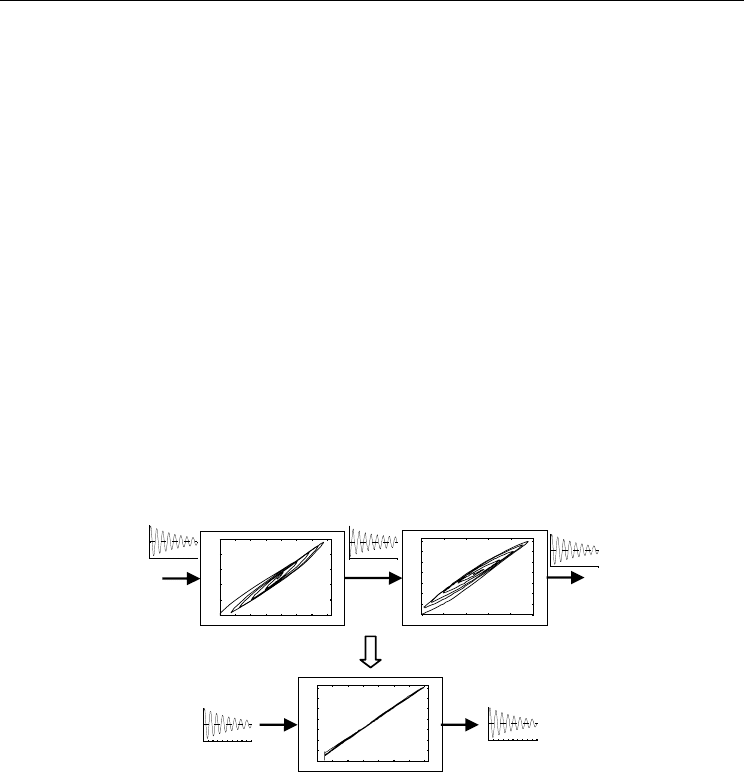
Human-Robot Interaction
372
categories: (1) Linear control with feedforward inverse hysteresis model; (2) Microscopic
theories; (3) Electric Charge Control; (4) Phase Control; and (5) Closed-loop displacement
control. The more recent methods comprise a hybrid of the methods.
Category (1) relates the underlying understanding of the material at microscopic level with
respect to displacement. Landauer et al., 1956 discussed the dependence of the polarization,
in barium titanate, on the rate at which the field is cycled. Category (2) makes use of the
knowledge that the hysteresis of the actuator’s displacement to the applied voltage is about
15% while the displacement to induced charge is 2%. This motivated Furutani et al.
[Furutani et al., 1998] to combine induced charge feedback with inverse transfer function
compensation. Category (3) includes Cruz-Hernandez & Hayward [Cruz-Hernandez &
Hayward, 1998; 2001] proposing the idea of considering phase as a control approach to
design a compensator to reduce hysteresis. Category (4) consists of many different
approaches. Some proposed incorporating inverse hysteresis model with a controller while
others proposed advance controllers like neural network [Hwang et al. 2003], fuzzy logic
[Stepanenko et al. 1998], sliding mode [Abidi et al. 2004] and H
control [Chen et al. 1999].
Category (5), a phenomenological approach, is about obtaining a mathematical
representation of the hysteresis motion through observation. Phenomenological approach is
more commonly used because the underlying physics of the relationship of the smart
materials like piezo-actuator’s hysteresis path with rate and load is not well understood.
Thus, there are many different attempts to derive different mathematical models that best
describe the complex hysteretic motion. The inverse model is then used as a feedforward
controller to linearize the hysteresis response as shown in Fig. 5.
0 2 4 6 8 10 12 14
0
2
4
6
8
10
12
14
0 2 4 6 8 10 12 14
0
20
40
60
80
100
0 20 40 60 80 100
0
2
4
6
8
10
12
14
Γ
−1
I
Γ
Figure 5. Linearization of Hysteresis Model using Inverse Feedforward Controller
A number of hysteresis mathematical models have been proposed over the years. Hu et al.
[Hu et al., 2002] and Hughes et al. [Hughes et al., 1995] proposed using the Preisach model
while Goldfarb et al. [Goldfarb et al., 1996; 1997] and Choi et al. [Choi et al., 1997] used
Maxwell’s model. Tao [Tao, 1995] used the hysteron model. The more recent papers are a
variation from the classical models to avoid certain conditions.
Another model is the Prandtl-Ishlinskii model. [Kuhnen & Janocha, 2001; 2002] and [Janocha
& Kuhnen, 2000] demonstrated that the classical Prandtl-Ishlinskii operator is less complex
and its inverse can be computed analytically. Thus, it is more suitable for real-time
applications because minimal mathematical computation time is required. Unfortunately, to
use the model, the operating frequency must not be too high as the hysteresis non-linearity
becomes more severe. Like most models, the classical Prandtl-Ishlinskii model is unable to
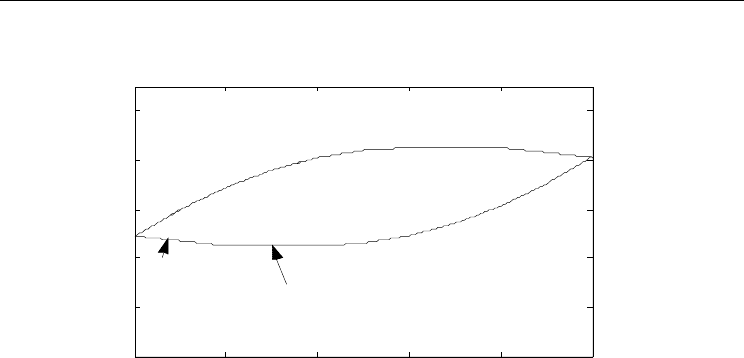
Modeling and Control of Piezoelectric Actuators for Active Physiological Tremor Compensation
373
function as a feedforward controller when the largest displacement does not occur at the
highest input signal (Fig. 6) as singularity occurs in the inverse.
Figure 6. Ill-Conditioned Hysteresis
In this chapter, there are two main contributions: (1) In order to accommodate human
tremor’s modulating frequency behaviour, a rate-dependent feedforward controller is
proposed; and (2) a solution to the inverse of the ill-conditioned hysteresis because as the
velocity or load increases, the slope of the hysteretic curve at the turning point tends to 0
and then negative, creating a singularity problem. This is achieved by mapping the
hysteresis through a transformation onto a singularity-free domain where the inversion can
be obtained.
3. Hysteresis Modeling
3.1 Prandtl-Ishlinskii (PI) Operator
The elementary operator in the PI hysteresis model is a rate-independent backlash operator.
It is commonly used in the modeling of backlash between gears with one degree of freedom.
A backlash operator is defined by
[]
)(,)(
0
tyxHty
r
=
{}{}
)(,)(min,)(max Ttyrtxrtx −+−=
(1)
where x is the control input, y is the actuator response, r is the control input threshold value
or the magnitude of the backlash, and T is the sampling period. The initial condition of (1) is
normally initialised as
{}{}
),)0(min,)0(max)0(
0
yrxrxy +−= (2)
where y
0
∈ℜ, and is usually but not necessarily initialized to 0. Multiplying the backlash
operator H
r
by a weight value w
h
, the generalized backlash operator is
[]
)(,)(
0
tyxHwty
rh
= . (3)
0 2 4 6 8 10
0
2
4
6
8
10
Input Voltage
D
i
s
p
l
a
c
eme
n
t
Negative
Gradient
Zero Gradient
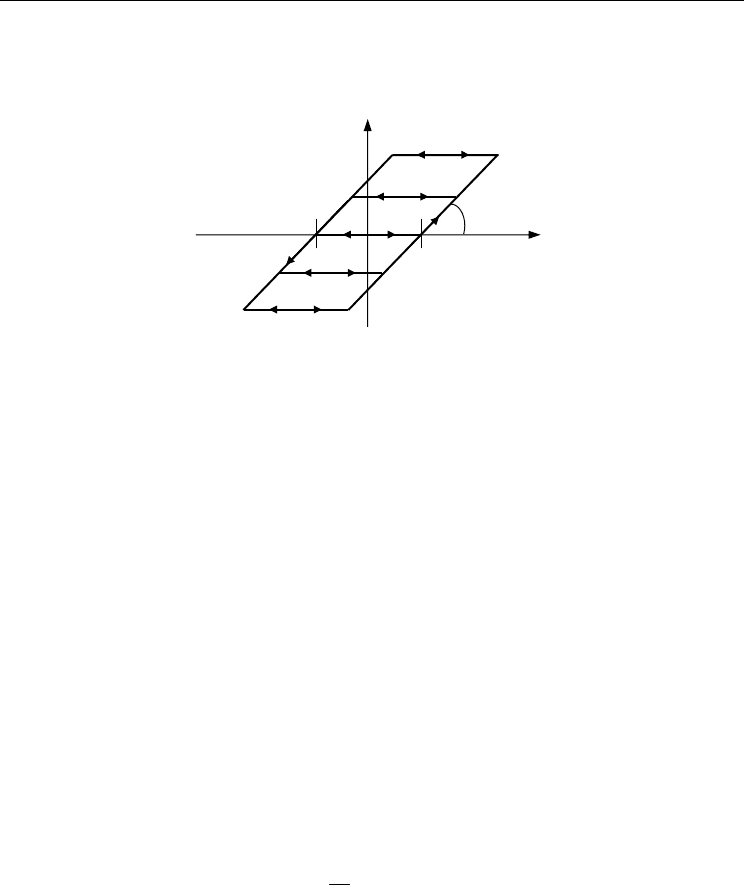
Human-Robot Interaction
374
The weight w
h
defines the gain of the backlash operator (w
h
= y/x, hence w
h
=1 represents a
45° slope) and may be viewed as the gear ratio in an analogy of mechanical play between
gears, as shown in Fig.7.
Figure 7. The rate-independent generalized backlash operator is characterized by the
threshold or backlash magnitude, r, and the weight or backlash operator gain, w
h
Complex hysteretic nonlinearity can be modeled by a linearly weighted superposition of
many backlash operators with different threshold and weight values,
[]
)(,)(
0
tyxHwty
r
T
h
&
&
&
=
, (4)
with weight vector
T
h
w
&
= [w
h0
… w
hn
] and
[]
)(,
0
tyxH
r
&
&
= [H
r0
[x, y
00
](t) … H
rn
[x, y
0n
](t)]
T
with
the threshold vector
r
&
= [r
0
… r
n
]
T
where 0 = r
0
< … < r
n
, and the initial state vector
0
y
&
= [y
00
… y
0n
]
T
. The control input threshold values
r
&
are usually, but not necessarily, chosen to be
equal intervals. If the hysteretic actuator starts in its de-energized state, then
.0
10 ×
=
n
y
&
&
Equation (4) is the PI hysteresis operator in its threshold discrete form. The hysteresis model
formed by the PI operator is characterized by the initial loading curve (Fig. 8). It is a special
branch traversed by equation (4) when driven by a monotonically increasing control input
with its state initialized to zero (i.e. y(0) = 0). The initial loading curve is defined by the
weight values
h
w
&
and threshold values
r
&
,
¦
−=
=
i
j
jhj
rrwr
0
),()(
ϕ
r
i
≤ r < r
i+1
, i = 0, …, n. (5)
The slope of the piecewise linear curve at interval i is defined by W
hi
, the sum of the weights
up to i,
¦
==
=
i
j
hjhi
wr
dr
d
W
0
)(
ϕ
. (6)
The subsequent trajectory of the PI operator beyond the initial loading curve with non-
negative control input is shown as the dotted loop in Fig. 8. The hysteresis loop formed by
the PI operator does not return to zero with the control input. This behaviour of the PI
operator closely resembles the hysteresis of a piezoelectric actuator.
The backlash operators cause each of the piecewise linear segments to have a threshold
width of 2r beyond the initial loading curve. As such, there is no need to define any
r
y
x
w
h
-r
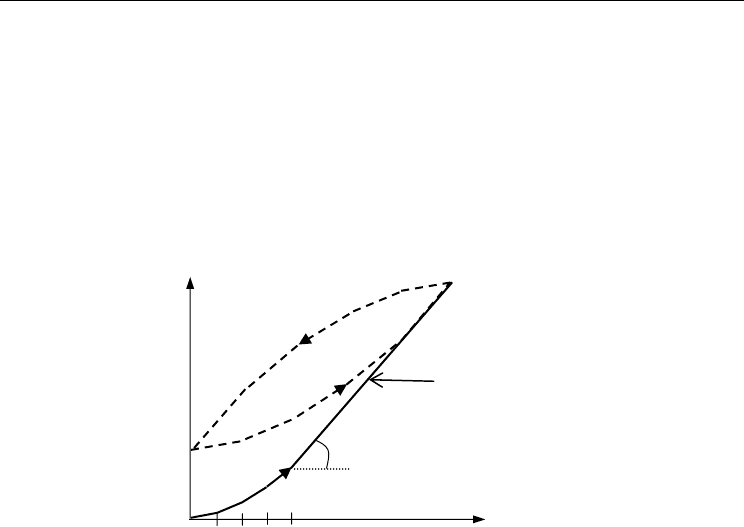
Modeling and Control of Piezoelectric Actuators for Active Physiological Tremor Compensation
375
backlash operators beyond the midpoint of the control input range, i.e. r
n
≤ ½max{control
input} [Ang 2003]. This also implies that the backlash operators have descending importance
from the first to the last, since the first operator is always used and the subsequent operators
are only used when the control inputs go beyond their respective threshold values, r
i
’s.
Moreover, observations from the piezoelectric hysteretic curves suggest that more drastic
changes in the slope occur after the turning points, i.e. in the region of the first few backlash
operators. To strike a balance between model accuracy and complexity, the authors propose
to importance-sample the threshold intervals
r
&
, i.e., to have finer intervals for the first few
backlash operators and increasing intervals for the subsequent ones.
Figure 8. The PI hysteresis model with n = 4. The hysteresis model is characterized by the
initial loading curve. The piecewise linear curve is defined by the equally spaced threshold
values
r
&
and the sum of the weight values
h
w
&
.
3.2 Modified Prandtl-Ishlinskii (PI) Operator
The PI operator inherits the symmetry property of the backlash operator about the center
point of the loop formed by the operator. The fact that most real actuator hysteretic loops
are not symmetric weakens the model accuracy of the PI operator. To overcome this overly
restrictive property, a saturation operator is combined in series with the hysteresis operator.
The general idea is to bend the hysteresis. A saturation operator is a weighted linear
superposition of linear-stop or one-sided dead-zone operators. A dead-zone operator is a
non-convex, asymmetrical, memory-free nonlinear operator (Fig. 9). A one-sided dead-zone
operator and a saturation operator are given by
¯
®
=
>−
=
0),(
0},0,)(max{
)]([
dty
ddty
tyS
d
(7)
[]
)()( tySwtz
d
T
s
&
&
= , (8)
where y is the output of the hysteresis operator, z is the actuator response,
T
s
w
&
= [w
s0
… w
sm
]
is the weight vector,
d
S
&
[y](t) = [S
d0
[y](t) … S
dm
[y](t)]
T
with the threshold vector d
&
= (d
0
…
¦
=
=
i
j
hjhi
wW
0
y
x
Initial loading
curve
r
i
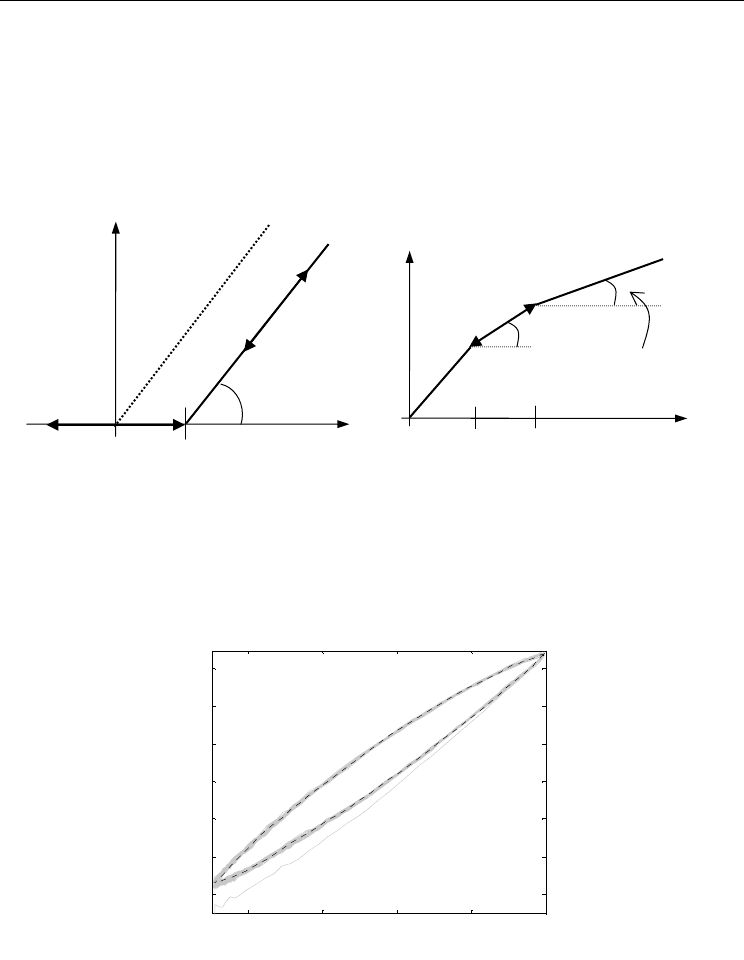
Human-Robot Interaction
376
d
m
)
T
where 0 = d
0
< d
1
< … < d
m
. For convenience, intervals of d
&
between d
0
and d
m
need not
be equal. Good selection of
d
&
depends on the shape of the hysteresis loop, and typically
involves some trials and errors.
The modified PI operator is thus
[]
)()( txtz
Γ
=
[]
[
]
)(,
0
tyxHwSw
r
T
hd
T
s
&
&
&
&
&
=
. (9)
Figure 9. (a) The one-sided dead-zone operator is characterized by the threshold, d, and the
gain, w
s
. (b) The saturation operator with m = 2. The slope of the piecewise linear curve at
interval i, W
si
is defined by the sum of the weights up to i.
3.3 Parameter Identification
Figure 10. The lighter solid lines are the measured piezoelectric actuator response to a 10
Hz, 12.5
μm p-p sinusoidal control input. The dark dotted line is the identified modified PI
hysteresis model with 10 backlash operators (n = 9) and 4 dead-zone operators (m = 3).
d
i
y
d
0
d
1
¦
=
=
i
j
sjsi
wW
0
z
(b)
z
y
d > 0
w
s
d = 0
(a)
20 40 60 80 100
2
4
6
8
10
12
14
Control Input (V)
Displacement (μm)
20 40 60 80 100
2
4
6
8
10
12
14
Control Input (V)
Displacement (μm)

Modeling and Control of Piezoelectric Actuators for Active Physiological Tremor Compensation
377
To find the hysteresis model parameters as shown in Fig. 10, we first have to measure
experimentally the responses of the piezoelectric actuator to periodic control inputs. A good
set of identification data is one that covers the entire operational actuation range of the
piezoelectric actuator at the nominal operating frequency. Next decide the order of the PI
operator (n) and the saturation operator (m), and set the threshold values
r
&
and d
&
as
described in the previous section. The weight parameters
h
w
&
and
s
w
&
are found by
performing a least-squares fit of (9) to the measured actuator response, minimizing the error
equation which is linearly dependent on the weights:
[]
(
)
[]
[
]
)(')(),(,,,
'0
tzSwtytxHwtwwzxE
d
T
sr
T
hsh
&
&&
&
&&
*
−=
. (10)
Fig. 10 shows superposition of the identified modified PI hysteresis model on the measured
piezoelectric actuator response, subjected to a sinusoidal control input.
3.4 Inverse Modified Prandtl-Ishlinskii (PI) Operator
The key idea of an inverse feedforward controller is to cascade the inverse hysteresis
operator, Γ
−
1
, with the actual hysteresis which is represented by the hysteresis operator, Γ, to
obtain an identity mapping between the desired actuator output )(
ˆ
tz and actuator response
z(t),
[]
[
]
[]
)(
ˆ
)(
ˆ
)(
ˆ
)(
1
tztzItztz ==ΓΓ=
−
(11)
The operation of the inverse feedforward controller is depicted in Fig.6.
The inverse of a PI operator is also of the PI type. The inverse PI operator is given by
[] []
[
]
)(',
ˆ
'')(
ˆ
0''
1
tyzSwHwtz
d
T
sr
T
h
&
&
&
&
&
=Γ
−
(12)
where the inverse modified PI parameters can be found by
0
0
1
'
h
h
w
w =
;
))((
'
1
00
¦¦
−
=
−
==
i
j
hj
i
j
hj
hi
hi
ww
w
w
, i = 1 … n;
¦
−=
=
i
j
jihji
rrwr
0
),(','
1
0
0
00
¦¦
+=
+==
n
ij
jhj
i
j
ihji
ywywy i = 0 … n; (13)
0
0
1
'
s
s
w
w =
;
))((
'
1
00
¦¦
−
=
−
==
i
j
sj
i
j
sj
si
si
ww
w
w
, i = 1 … m;
¦
−=
=
i
j
jisji
ddwd
0
),(' i = 0 … m; (14)
4. Rate-Dependent Phenomena
Most, if not all, of the present mathematical models are defined rate-independent
mathematically. This is too restrictive in real life. In this section, a rate-dependent hysteresis
model is proposed.
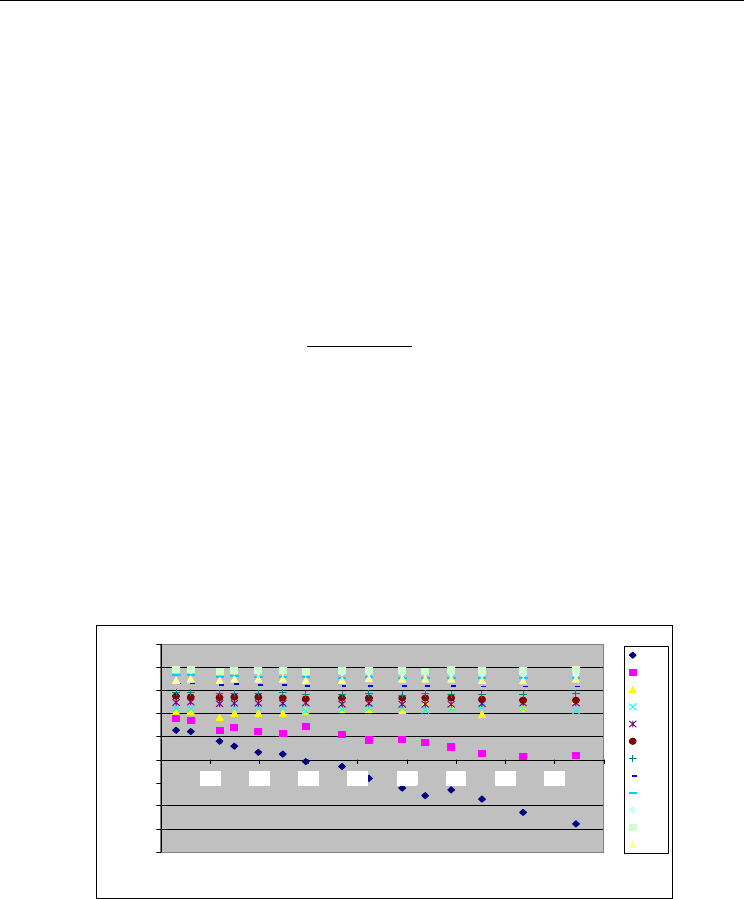
Human-Robot Interaction
378
4.1 Rate-dependent Hysteresis Slope
In this section, an extension to the modified PI operator is proposed in order to also model
the rate-dependent characteristics of the piezoelectric hysteresis is proposed. One of the
advantages of the PI hysteresis model is that it is purely phenomenological; there are no
direct relationships between the modeling parameters and the physics of the hysteresis.
While the rate dependence of hysteresis is evident from Fig. 4, the sensitivity of actuator
saturation to the actuation rate is not apparent. Hence, assuming that saturation is not rate-
dependent and hold the saturation weights,
s
w
&
, as well as the threshold values,
r
&
and d
&
,
constant a relationship between the hysteresis and the rate of actuation )(tx
is constructed.
The hysteresis slope (i.e., sum of the PI weights) at time t as a rate-dependent function is
)),((
ˆ
))(( txfWtxW
hihi
+= i = 1 … n.; (15)
where
.0)0(,
)()(
)( =
−−
= x
T
Ttxtx
tx
(16)
4.2 Rate-dependent Model Identification
The piezoelectric actuator, subjected to periodic constant-rate or sawtooth control inputs.
Measurements were made over a frequency band whose equivalent rate values cover the
entire operational range of the actuation rates. For example, in an application tracking
sinusoids of up to 12.5
μm p-p in the band of 1 to 19 Hz, the operational range of the
actuation rate is from 0 to 746
μm/s, which corresponds to the rate of 12.5 μm p-p sawtooth
waveforms of up to about 60 Hz. PI parameter identification is then performed on each set
of measured actuator responses. The sum of the hysteresis weights W
hi
, i = 0 … n, of each
identification is then plotted against the actuation rate )(tx
and shown in Fig. 11.
Figure 11. Plot of Sum of hysteresis weights against actuation rate
From Fig. 11, it can be seen that the hysteresis slope of the piezoelectric actuator can be
modelled as linear to the velocity input with good approximation. Thus the rate-dependent
hysteresis slope model would be:
),(
ˆ
))(( txcWtxW
ihihi
+=
i = 0 … n (17)
-4
-3
-2
-1
0
1
2
3
4
5
0
100 200 300 400 500 600 700 800 900
Velocity (μm/s)
Sum of weight
s
W0
W1
W2
W3
W4
W5
W6
W7
W8
W9
W10
W11

Modeling and Control of Piezoelectric Actuators for Active Physiological Tremor Compensation
379
where c
i
is the slope of the best fit line through the W
hi
’s and the referenced slope, ƍ
hi
, is the
intercept of the best fit line with the vertical W
h
axis or the slope at zero actuation. The
individual rate-dependent hysteresis weight values can be calculated from
)),(())(())((
)1(
txWtxWtxw
ihhihi
−
−= i = 1 … n;
))(())((
00
txWtxw
hh
= . (18)
4.3 Rate-dependent Modified Prandtl-Ishlinskii Operator
The rate-dependent modified PI operator is defined by
[]
)(,)( txxtz
Γ
=
[]
[
]
)(,)(
0
tyxHxwSw
r
T
hd
T
s
&
&
&
&
&
= (19)
The inverse rate-dependent modified PI operator is also of the PI type:
[] []
[
]
)(',
ˆ
')(')(
ˆ
0''
1
tyzSwHxwtz
d
T
sr
T
h
&
&
&
&
&
=Γ
−
. (20)
The inverse rate-dependent parameters can be found by (13), replacing
h
w
&
with the rate-
dependent
)(xw
h
&
,
()
()
)(
1
)('
0
0
txw
txw
h
h
= ;
()
()
() ()
)()(
)(
)('
)1(
txWtxW
txw
txw
ihhi
hi
hi
−
−
=
, i = 1 … n;
()
¦
−=
=
i
j
jihji
rrtxwr
0
),()('
i = 0 … n;
() ()
,)()('
1
0
0
00
¦¦
+=
+==
n
ij
jhj
i
j
ihji
ytxwytxwy
i = 0 … n. (21)
5. Motion Tracking Experiments
Two motion tracking experiments were performed to demonstrate the rate-dependent
feedforward controller. The first experiment compares the performance of the open loop
feedforward controllers driven at fix frequencies. The rate-independent controller is based on
the modified PI hysteresis model identified at the 10Hz at 12.5μm peak to peak sinusoid. The
second experiment is tracking a multi-frequency (1, 10 and 19 Hz) nonstationary motion profile.
5.1 Experiment Setup
Figure 12. Experimental Architecture
16-bit D/A
16-bit A/D
PC
Amplifier
Module
Piezoelectric
Actuator
Interferometer Displacement
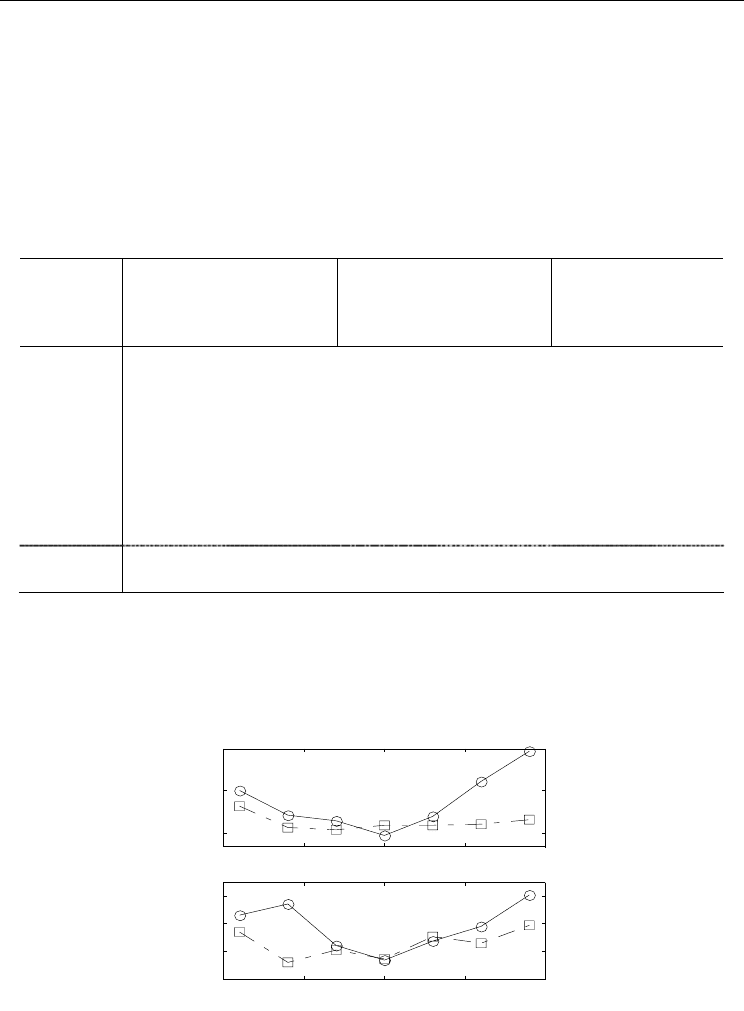
Human-Robot Interaction
380
As seen from Fig. 12, a 16-bit D/A card is used to give out the necessary voltage, which is
then passed through the amplifier (the gain is approximately 10). Given the voltage, the
actuator will move and the interferometer will detect the displacement and convert it to
analog voltage. Using a 16-bit A/D card, the PC reads in the displacement.
5.2 Stationary Sinusoid Experiment
The first experiment compares the performance of the rate-independent and rate-dependent
modified PI models based open-loop feedforward controllers in tracking 12.5 μm p-p
stationary sinusoids at 1, 4, 7, 13, 16 and 19 Hz. The tracking rmse and maximum error of
each controller at each frequency are summarized in Table 1 and plotted in Fig. 13.
Without Model Rate-independent Rate-dependent
Freq. (Hz)
rmse (μm) max ε (μm) rmse (μm) max ε (μm) rmse (μm)
max ε
(μm)
1 1.13 2.11 0.25 0.63 0.21 0.57
4 1.12 2.07 0.19 0.67 0.16 0.46
7 1.23 2.24 0.18 0.52 0.16 0.50
10 1.19 2.26 0.14 0.46 0.17 0.47
13 1.21 2.31 0.19 0.53 0.17 0.55
16 1.30 2.49 0.27 0.59 0.17 0.53
19 1.37 2.61 0.34 0.70 0.18 0.59
Mean
±
σ
1.22
± 0 09
2.30
± 0.19
0.23
± 0.07
0.59
± 0.8
0.18
± 0.02
0.52
±0.05
The rmse’s and max errors are the mean results over a set of three 5-second (5000 data
points) experiments.
Table 1. Measured Performance of the Rate-Independent and Rate-Dependent Inverse
Feedforward Controllers
Figure 13: Experimental tracking results of different controllers for stationary 12.5 μm at 10
Hz
0 5 10 15 20
0.15
0.25
0.35
0 5 10 15 20
0.4
0.5
0.6
0.7
rmse (μm)
max error (μm)
Frequency (Hz)
Rate-independent Rate-dependent
0 5 10 15 20
0.15
0.25
0.35
0 5 10 15 20
0.4
0.5
0.6
0.7
rmse (μm)
max error (μm)
Frequency (Hz)
Rate-independent Rate-dependent
